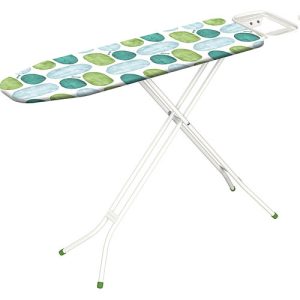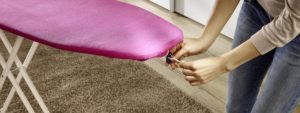
prom.ua
The first ironing board was patented back in 1858 by Americans Vanderburgh and Harvey. In appearance, it differed from the modern one and had special devices for smoothing the sleeves. In 1982, Sarah Brown gave this design its familiar look.
Nowadays, an ironing board is a necessary item in any home. Without using it, it is impossible to properly iron wrinkled or dried out items after washing.
But there is one problem - dimensions. The board is quite big. It needs to be stored somewhere. To install, pull it out, unfold it, fold it and put it back in place. This process takes time, and storing them reduces space in the apartment. To avoid these difficulties, models of built-in ironing boards have been developed that are convenient to use and do not spoil the interior of the apartment. These are wall-mounted models, folding ones, and transformable boards.
And it is not at all necessary to buy them in a retail chain.A DIY ironing board at home will turn out no worse, and maybe even better, than one purchased in a store. You can install it yourself into furniture or a wall, or choose a color to match the interior. And if folded, you push it into a desk drawer, it won’t be visible at all.
DIY ironing board. Product types
An ironing board built into the wall is quite easy to make with your own hands. It can be built into a wall, partition, or closet. Let's look at how to make an ironing board with your own hands and what we need for this:
So, a do-it-yourself wooden ironing board is made according to the following scheme:
- If the board will be installed in a niche, create a niche in the wall. It should be at a distance of 80 cm from the floor level.
- We prepare a long board 125x40 mm (it is better not to use plywood, it can deteriorate under the influence of high temperatures during ironing).
- We make a frame for installing the board.
- We build the jumper into the frame, which should rotate quite freely. We use bolts for upholstered furniture. We drill holes equal to 10 mm at a distance: below - 110 mm, in front - 15 mm, from the edge - 10 mm.
- We strengthen the jumper on the guides.
- We fasten the handles on the other side - to remove the fixation.
- To fix the structure, bend the corner near the handle inward by 45°.
- We also bend the plate inward by 45° and secure it to the frame.
- We install the central pipe fasteners in the center, install it and tighten the screw.
- We collect the remaining tubes.
- We remove the guides and secure them with self-tapping screws.
- We check the completed structure and install bolts for safety reasons.
- We cover the boards:
We cover the board with a bath towel and secure the corners with a furniture stapler. The fabric should be very well stretched and not form wrinkles. If the stapler does not penetrate, we finish it off with a hammer.
We cover the board with facing material. This fabric must be resistant to temperature changes. We attach it like the first layer.
- We install a swing door or a retractable system, which is more compact.
- We decorate the doors with a mirror, wallpaper to match the walls or in other ways.
A convenient DIY ironing board for the wall is ready.

prom.ua
An ironing board is often used at home, a drawing of which can always be found on the Internet. This is a transforming ironing board, which is also easy to make with your own hands.
The tabletop of the product folds in half, which reduces the size of the board in half. The tabletop is attached to the guides. The disadvantage is that it can withstand little weight (which the guides can support). An undeniable advantage is its compactness.
A wardrobe is also a very suitable place to install an ironing board. You just need to check the strength of the back wall to which the board will be attached. A do-it-yourself folding ironing board in a closet is the best installation option. How to assemble the ironing board in this case:
- Take measurements;
- If there are unnecessary partitions, saw them off;
- The size of the ironing board should be equal to the size of the drawer into which it will slide.
Use a simple mechanism - hinged mounts. Use them to secure the board tightly.
There are other options for attaching boards in the house. For example, a DIY wall-mounted ironing board is also within the power of the home craftsman. This mounting option is even simpler than others.We know that the space behind the door is often unused. Let's adapt it for this purpose.
Mounting to the wall is very simple - hammer 2 metal coat hooks into the wall and that’s it.
With the same success, you can attach the board to the door, but then it would be better to drive in a couple of nails and bend them for additional fixation.
Another option for how to make an ironing board and where to install it is a wall cabinet. If making such a piece of furniture is not particularly difficult for you, it will be a real decoration for your hallway, kitchen or bathroom. Any housewife will appreciate this design.
The question of how to make an ironing board stable arises very often. It's all about the legs, which come in:
- A-shaped - quickly loosen;
- T-shaped – very stable, easy to fold;
- U-shaped - loose, not stable;
The method of fastening the legs also needs to be taken into account - bolted fastening is preferable, since it can always be tightened in case of loosening. But you can’t fix the fastening with rivets.
In addition to standard ironing boards, there are small mini-boards for ironing small items or parts thereof. These are ironing sleeves. They are a small stand on which there is a narrow rectangle with a hard surface and rounded edges. It is very convenient to iron shirt sleeves. Often these boards serve as an addition to a large ironing board and are included in the kit. But you can make it yourself.
A homemade ironing board for sleeves can easily replace one purchased in a store. To work, you need to purchase a wooden board or chipboard and a metal sheet. You will also need screws, a hacksaw and a drill.
- Cut a piece of 10x50 cm from the board.
- We cut out a 10x15 cm bracket from a metal sheet and bend it to make it look like a Z.
- In the upper and lower parts we drill 2 holes for fastening.
- We attach it to a large ironing board with screws.
Now you know what types of ironing boards exist and you can clearly determine which one to make with your own hands. Do not forget to take into account the design of the room and do not go beyond its color scheme.


 0
0





